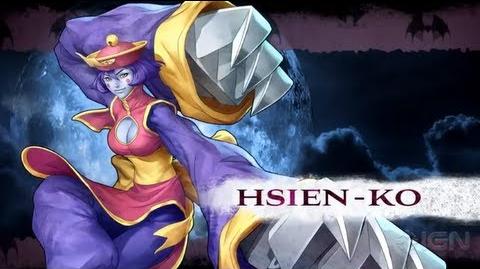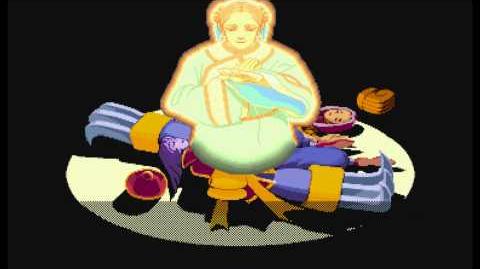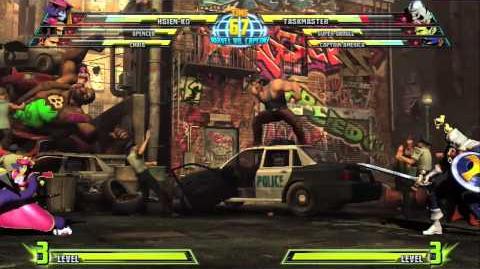Hsien-Ko (Lei-Lei
累
, レイレイ, Rei-Rei in Japan) was first introduced in Night Warriors: Darkstalkers' Revenge along with her sister, Mei-Ling (Lin-Lin, リンリン, Rin-Rin in Japan). Her character is based off the Chinese hopping vampire, also known as Jiang Shi. Hsien-Ko has appeared in several non-Darkstalkers games such as Pocket Fighter and Marvel vs. Capcom 3.
Background
Hsien-Ko and Mei-Ling were twins born in a family of Senjutsushis. Both of them were raised to be Senjutsushis and were taught Senjutsu. On the ceremonial night when they were to become a Senjutsushi, their village was attacked by Darkstalkers. The mother of the twin girls gave her life to protect the sisters, but because of this, her soul was trapped in darkness. To release their mother's soul from the darkness, Hsien-Ko uses the Igyo Tenshin technique to turn into a Jiang-Shi. Mei-Ling, her older sister, turns into a ward to make sure Hsien-Ko doesn't lose control of herself. The two set off to hunt down Darkstalkers as a Darkhunter of the night.
After the two had freed their mother's soul from the darkness, the two were reincarnated with the powers of their mother. The two were reborn in a normal family and were raised in happiness. On their 16th birthday, the powers of the two sisters awoke. These powers had been passed down from the very first member of the Shao family. This was their mother's way of repaying her daughters for saving her soul. But because of this, Jedah sensed their power and deemed them as worthy souls.
The two dreamed again on the night their powers awoke. It was a nightmare which was caused by Jedah's summoning. In the nightmare, their souls were instantly transferred to Majigen. This place was where the Senjutsushi's and the Darkstalkers battled. It was a legendary land and Hsien-Ko and Mei-Ling's homeland. Their leftover bodies had no soul in them anymore. They lied there side by side with no sign of life.
When they awoke, the two of them had no memory of their previous battle. They didn't know why they were in Majigen. But they both felt strongly that they must win the battle to return to the real world. To them, it was a weird feeling, like watching a bad nightmare.

Their form in Majigen was the form which is best suited for battle. It is the same form they took when Pyron came to Earth. This was due to their mother lending them some powers. Though the two of them had experience as Darkhunters, they were now just ordinary girls. To survive in the world where demons live, they needed their powers of Senjutsu. With help from their mother, they could use various arts without any thought. However, the moment the two sisters lose trust in each other, their powers would be lost instantly.
After the events of Vampire Savior, their souls are once again consumed by the darkness, but their mother's soul saved them once again. The two sisters returned to the human world and went back to their normal lives again.
Weapons and Abilities
- Kunai
- Akuma (Gouki) statue
- Chun Li's bracelets
- Giant gauntlets
- Knives
- Giant saw blade
- Weights
- Spiked balls
- Giant daggers
- Axe
- Shuriken
- Star blocks
- Mei-Ling
- Swords
- Boomerangs
- Rocks
- Sledgehammer
- Small barrels
- The ability to run on air
- The ability to teleport or disappear for a limited amount of time
- Chains
- Vega's claws
- Chinese bombs
- Bonsai Tree Plants
- Felyne plush doll (only in Marvel vs Capcom 3)
About real Jiang Shi
 Main article: Jiang Shi
Main article: Jiang Shi
Geong Si, Jiang Shi (Putonghua) or Kuang Shi (Cantonese) are the zombies of Chinese myth. They are caused by the demonic possession of a recently deceased corpse and said to have a terrifying appearance. They have physical bodies, but they are not alive, nor have will or thought. They are closer to Haitian zombies than to anything else in widely-known Western folklore. As it matures, it gains new skills with the older among them rumored to have the ability to fly.
Before the Civil War and before World War II, it was said that the dead still walked the roads of rural China in parades marching toward their ancestral villages. Buried away from the family, a dead Chinese had no feasts, no paper clothes, slaves, boats, food, or incense burnt to him, since all these things are in the hands of his descendants. Such is the spiritual importance of the Chinese ancestral village.
When a Chinese person dies away from home, there are several ways to return his body to native earth, but the less-than-rich rural Chinese once used this form of underground railway. A medium or priest, especially a Taoist priest who had toiled in a specialized apprenticeship, would be hired by the village to bring their dead home, walking them along the roads, perhaps as one still sees geese herded down multi-lane highways in modern China.
Spells had a part in this ritual and in controlling the dead when they were made to walk, but there is nothing special or extraordinary about spells in the Chinese world. A wide variety of spells were usually written out on red paper called Dzi Dzat, the generic name given for the paper grave goods and ancestral sacrifices burnt to make a comfortable life for the dead.
Paper and bamboo mansions were burnt at funerals and at regular festivals. These dwellings for the spirits of the dead were filled with paper representations of everything the ancestors knew or had wanted in life: favorite food, books, signs of rank, a pleasure boat or a young mistress, all in painted and folded paper.
In some accounts of the Kuang Shi, a spell glued to the face of the body is the medicine that makes it move. This method is favored in popular film, since it is visible to the camera, and the viewer can always tell a Kuang Shi by his label. Traditional accounts do not agree on this point. In modern Hong Kong film, the Kuang Shi is the slave of the character of an evil Taoist priest, who launches platoons of these animated corpses at heroes of kung fu and even gangster movies. This picture of Kuang Shi in current film does not represent their old form. Nevertheless, the Kuang Shi remains one of the current, tangible, commonly believed myths of old China.
Appearances
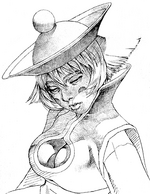
Darkstalkers 3 artwork
- Night Warriors: Darkstalkers' Revenge
- Darkstalkers 3
- Darkstalkers Chronicle: The Chaos Tower
- Darkstalkers Resurrection
In Japanese only games
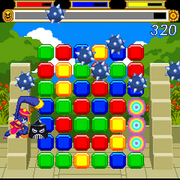
Lei-Lei's Magical Hammer
- Namco X Capcom
- SNK vs Capcom: Card Fighters' Clash
- SNK vs Capcom: Card Fighters 2
- SNK vs Capcom: Card Fighters DS
- Super Gem Fighter: Mini Mix (Pocket Fighter)
- Super Puzzle Fighter II Turbo
- Lei-Lei's Magical Hammer (cellphone game)
- Marvel vs Capcom 3: Fate of Two Worlds
- Onimusha Soul (browser game)
- Ultimate Marvel vs Capcom 3 (Mei-Ling as a DLC costume)
- Project X Zone
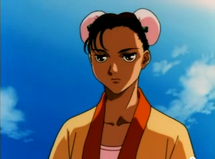
Hsien-Ko in the Darkstalkers anime
Hsien-Ko appears in Darkstalkers the Animated Series in the episodes "Ghost Hunter" and "Darkest Before Dawn". Unlike her video game counter part, in the cartoon series Hsien-Ko no longer has blue skin but instead has normal flesh. To tie her storyline with the remaining cast, Hsien-Ko's family was killed by Demitri Maximoff and turns into a Chinese vampire after meeting the Lady of Mercy.
In the Night Warriors: Darkstalkers' Revenge OVA, Hsien-Ko first appears along side her sister in the second story, Blood of the Darkstalkers, Power of the Darkstalkers. In Udon's Darkstalkers series, she makes a cameo in the mini for issue one and later another small appearance in the second series, issue one.Trivia
- Hsien-Ko's Chinese name Hé Xiān Gū(何仙姑) comes from one of the Eight Immortals in the Taoist pantheon.
- Hsien-Ko was planned to be in Tatsunoko vs. Capcom as a playable character but was dropped.[2]
- Lord Raptor seems to have some sort of romantic interest in Hsien-Ko, do to him being a fellow undead monster, as demonstrated by his special intro towards her, but she does not seem to share this interest in (non-canon) spinoffs. In Namco x Capcom, Raptor constantly attempts to woo her, but she finds him irritating and wants nothing to do with him. She also mentions her dislike of Raptor in the Marvel Vs. Capcom 3, saying her opponent was annoying, but not nearly as annoying as Lord Raptor.
- Xiao Lon from The King of Fighters Maximum Impact Regulation "A" also seems inspired by Hsien-Ko in terms of appearance and especially fighting style.
- Taokaka from the BlazBlue series may also be a reference, having large sleeves with metal claws and saws in them.
- Hsien-Ko was announced in Project X Zone along with fellow Capcom character Frank West, who is ironically a man who fights zombies.
- Hsien-Ko and Mei-Ling are mostly likely fraternal twins, as neither of them look similar (Hsien-Ko has spiky purple hair, and Mei-Ling has straight brown hair).
- Hsien-Ko has had the same voice actress in nearly all of her video games appearances up to Namco X Capcom: Michiko Neya (the exception being Super Puzzle Fighter II Turbo, where Kae Araki took over). As of Marvel vs Capcom 3 she is now voiced by Saori Hayami.
- In Vampire Savior, Mei-Ling is also voiced by Michiko Neya via reverb and in Pocket Fighter using an unregulated voice. Despite this she is voiced by actresses different from those of Hsien-Ko in all other appearances in Japanese media as well as all English appearances.
- Ironically, in the Night Warriors OVA, Hsien-Ko looked exactly like Chun-Li from the Street Fighter series in her previous life.
- Furthering this resemblence is the fact that her Japanese OVA voice, Yuko Miyamura, voiced Chun-Li in most of her video game appearances in the late '90s.
- Her first appearances in both Namco X Capcom and Project X Zone have several things in common. She first appears in the fifth prologue chapter of the game. Both levels take place on a boat. She meets the representatives of Resident Evil in this stage. Also, she is attacked by Lord Raptor who greets her with the words "My sweetheart! Hsien-Kohhhh (Lei-Lei-chan)!!" in both games.
- For some reason, in Marvel vs Capcom 3, most of the English-speaking actors, including the announcer, cannot properly pronounce her name, instead saying it as "shin-ko", "sen-ko", "sheng-ko", and "hee-sen-ko". The correct way is in fact "syen-ko", as heard in Pocket Fighter.
- According to concept art, Hsien-Ko's many weapons are stored in carrying devices she holds onto, while her claw weapons are in fact chained directly to her scapulas.
- Hsien-Ko is the only character in the series to transform into more than one person when hit by Demitri's Midnight Bliss.
Sprite
Darkstalkers
series |
Super Puzzle Fighter II Turbo
|
Notes:
- Super Puzzle Fighter II Turbo sprite is also used in Pocket Fighter.
Official artwork

|

|

|

|

|
| The full image gallery for Hsien-Ko may be viewed here. |
Videos
| Darkstalkers cast |
| Main cast |
| Anita • Anakaris • Baby Bonnie Hood • Bishamon • Dee • Demitri Maximoff • Donovan Baine • Felicia • Hsien-Ko • Huitzil Jedah Dohma • Jon Talbain • Lilith • Lord Raptor • Morrigan Aensland • Pyron • Q-Bee • Rikuo • Sasquatch Victor von Gerdenheim |
| Secondary cast |
| Belial Aensland • Dark Talbain • Le Malta • Mei-Ling • Oboro Bishamon • Ozom |
| Other cast |
| Harry Grimoire • John Stately • Majorette/Thomas • Marionette • Shadow • Jack |
External Links
- Hsien-Ko - Strategy Wiki
- Hsien-Ko - Mizuumi Wiki
- Hsien-Ko - Capcom Database
- Hsien-Ko - Marvel vs. Capcom Wiki
References
- ↑ 1.0 1.1 1.2 1.3 Capcom, (2008). Darkstalkers Graphic File. Udon Entertainment Corp, pg. 105. ISBN 1897-37604-9
- ↑ http://www.siliconera.com/2009/05/17/these-characters-didnt-make-the-tatsunoko-vs-capcom-cut/









